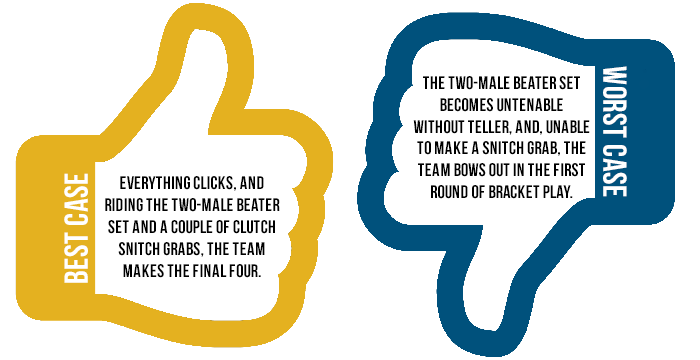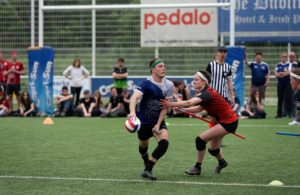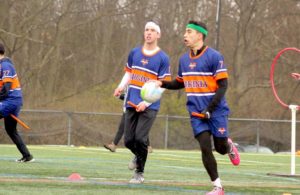- Rule, Britannia, no more?
- Unpopular Opinions: US Quadball Cup 2023
- Proven Contenders: University of Virginia
- Proven Contenders: Rutgers University
- Proven Contenders: University of Michigan
- Proven Contenders: Creighton University
- Different Perspectives: A Look Inside USA Ultimate
- Antwerp QC, Much of Belgian Core, Leaves Competitive Quidditch
Part X
Rock Hill Roll Call is your in-depth guide to the 80 teams that will compete for the title of World Cup 8 Champion. We’ve reached out to writers and analysts all over the country to bring you the lineups, strategies, focal points and aspirations of each and every attending team. Whether you are looking for a leg up on the competition or just want a detailed preview of the sport’s main event, this is the place for you.
 By Ethan Sturm
By Ethan Sturm
Kedzie Teller represented Boston quidditch like few others. A star in the city’s quidditch scene, Teller played in Boston for six years, won three regional titles, played for two iterations of Team USA and founded the city’s first completely unaffiliated community team, captaining it for a year and a half before moving to Texas. Suffice to say, he left a hole in QC Boston: the Massacre’s roster that is far bigger than his stature suggests.
Teller’s departure will have an effect on just about every aspect of how Massacre plays, from its chasing to its seeking to even its beating. Teller was the team’s best point defender, and its best off-ball threat offensively.
Let’s start there. Throughout the first semester, keeper and co-captain Jayke Archibald relied heavily on Teller to give the team’s offense a little bit of depth beyond Archibald’s bludgerless drives and distance shots. When Teller was having an off game or wasn’t on the pitch, Archibald struggled to involve the team’s other options. When neither Archibald nor Teller was on the pitch, the team’s second line often found itself in extensive scoring droughts that put the team in jeopardy. Brian Zanghi is the most likely candidate to step up offensively, but the team will need female chasers such as Elise Risio to step and take on some of the load as well.
Beyond offensive production, Massacre became known for its two-male beater sets, relying heavily on Max Havlin, Michael Sanders and Steve Houseman to dominate the field with bludgers and let the chasers roam wild. But with underwhelming contributions from Massacre’s female chasers, that strategy was more heavily predicated on Teller’s presence than the team would probably like to admit. By being both an effective point defender and an off-ball threat, Teller lessened the responsibilities of his fellow chasers. But while Sheldon Bostic may be just as effective at point defense (if he’s healthy) and Zanghi can contribute offensively, neither chaser is the full package. Because of that, Massacre will likely need to break out of its two-male beater set more often this semester to get what it needs from its chaser lines.
Then, of course, there is seeking. While Teller was never known for his seeking and rarely played the position for Massacre, he did have the team’s only SWIM situation catch of the season. While the situation was dire even when Teller was on the team, his departure didn’t improve matters.
So is Massacre’s goose cooked just because one player left? Of course not–there’s too much talent on this roster for that to be the case. While Teller leaving will give a lot of players a chance in the spotlight, I’m most excited to see what Max Blaushild can bring to the table in this spring. Always one of the most underrated players in Boston, straight through his Emerson College captaincy, he is, in many ways, built in Teller’s mold: an all-around talent who can hit, move off ball, pass and score around the hoops. If Massacre is going to revamp this semester, Blaushild will undoubtedly be at the heart of it.
By Anonymous
Right from brooms up, you will need to know how you want to combat this team. More often than not, Massacre is going to come out in a two-male beater set. This isn’t like the Lost Boys, a team that goes to this set at times when it’s advantageous. This is a team looking to get everything it can from it.
When Massacre sits in the two-male beater set, you either have to beat them or join them. If you stick to a standard set, unless you have an incredibly strong beating game, you are inherently conceding the bludger battle. Team USA member Havlin is an incredibly aggressive beater who will, with bludger control, look to use this strategy to actually take a territorial advantage over the game, pushing far from his hoops defensively and high up the pitch offensively. In fast-break situations, he will often be willing to throw to open up a no-bludger situation. If you can weather this storm while staying in a standard set, you will find yourself with a sizable advantage in the chaser game with mismatches all over the field.
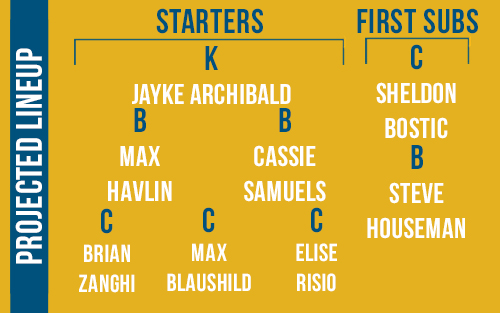 If you do decide to go into a two-male beater set yourself, you need to prioritize bludger control at all costs. If you don’t have it, you will find yourself in the same situation you would have been in with a standard set but without the chaser advantage. New York University succeeded maintaining control multiple times against Massacre by keeping its beaters close to the hoops, making pushes for bludger control as difficult as possible for Massacre.
If you do decide to go into a two-male beater set yourself, you need to prioritize bludger control at all costs. If you don’t have it, you will find yourself in the same situation you would have been in with a standard set but without the chaser advantage. New York University succeeded maintaining control multiple times against Massacre by keeping its beaters close to the hoops, making pushes for bludger control as difficult as possible for Massacre.
When Massacre is on the offensive, you need to respect all of the capabilities of Archibald’s game. With bludgers in the play, he will generally stay at the top of the zone, moving largely horizontally and looking for a pass. If one doesn’t show up in a reasonable amount of time, do not be surprised to see a shot, even from a good distance, especially if the keeper is out of position. In no-bludger situations, Archibald will regularly drive, using his lanky form and long limbs to make tackling a nightmare for the defense. In such situations, stopping him is paramount, even if it means leaving some passing options open. Beyond its top contributors, Massacre’s scoring threats decrease in potency rather quickly.
Breaking down its defense is perhaps the most difficult part of playing Massacre, as the team combines impressive point defending with Havlin’s cannon of an arm and Archibald’s range at keeper. It is important to respect the range, lest you waste a couple of early possessions with a floated pass or distance shot that Archibald gets easily. The best way to attack Massacre is working the perimeter with passes, ideally stretching Havlin’s positioning and taking advantage of a less-potent tackler than the point defender.
The team’s seeker game issues are well documented, and it’s important to know how to take advantage of them. Tufts University and RIT have both found themselves out of range with the snitch on the pitch against Massacre, only to ignore their opponent’s seeker and concentrate their beaters’ efforts on the seeker game. Both managed to get back in range before all was said and done. No matter how questionable a team’s seeking is, it is playing with fire to leave its seeker unopposed, but when none of your options look great, such a tactic can pay large dividends against Massacre.
 By David Hoops
By David Hoops
USQ Editorial Team Leader
As the junior varsity squad of the Bowling Green State University quidditch program, the Falcon Warriors have made a tremendous leap to World Cup 8 qualifier in their second season of existence–an impressive feat considering the other Midwest teams they had to jump in the process.
This achievement will undoubtedly help the entire Bowling Green program for years to come, giving every player from both teams the invaluable World Cup-playing experience that you cannot get anywhere else. But now the question is: How will the Falcon Warriors be successful this year in Rock Hill going up against competition the vast majority of its players haven’t witnessed?
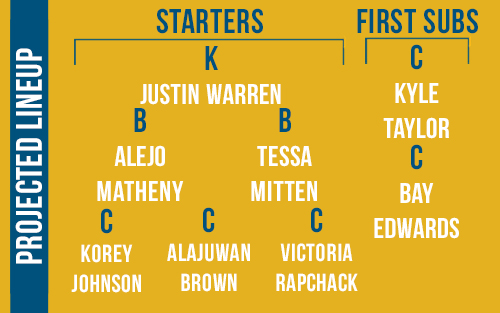 The person who will be called upon the most is chaser/keeper A.J. Miller. Miller is a first-year player who spent the fall helping the varsity Bowling Green squad reach the finals of the Midwest Regional Championship. He was then sent down to the Falcon Warriors to act as a leader for the inexperienced squad and immediately became its best quaffle player in the process.
The person who will be called upon the most is chaser/keeper A.J. Miller. Miller is a first-year player who spent the fall helping the varsity Bowling Green squad reach the finals of the Midwest Regional Championship. He was then sent down to the Falcon Warriors to act as a leader for the inexperienced squad and immediately became its best quaffle player in the process.
Miller is, quite simply, built like a truck, and he plays like one to boot. He was arguably the largest and hardest-hitting member of the varsity team and will be expected to bear the brunt of both the offense and defense for the Falcon Warriors. He was also known to occasionally don the yellow headband for the varsity squad, cementing the team’s Midwest Regional semifinal victory over Ball State University. The Falcon Warriors likely will not win too many games in Rock Hill, but the ones they can win will require Miller to dominate physically when he is on the field and change the pace for his otherwise finesse-based team.
 By David Hoops
By David Hoops
USQ Editorial Team Leader
Fall semester saw the Falcon Warriors qualify using the two strengths most young and inexperienced squads tend to struggle with: seeking and beating. Most of this can be credited to the knowledge the team gains from practicing with its varsity squad, one of the most talented teams in the region, but there is plenty of athletic talent as well. After a slow start, freshman seeker/chaser Korey Johnson has grown to become a dependable option for a team that will absolutely require snitch-range grabs to win in Rock Hill. Coupled with returning seeker Alajuwan Brown, the Falcon Warriors have enough talent and firepower in that department to sneak into wins once they are in snitch range.
The beating game for this JV squad is also ahead of its expected experience level. The Falcon Warriors chasing game has yet to develop a dependable tackling strategy (outside of Miller) and places a lot of the defensive responsibility on the black headbands. Captain Alejo Matheny couples with Tessa Mitten to create a dependable duo defined by consistently good decision-making under pressure. The Falcon Warriors have unfortunately lost their best beater–the speedy Max Portillo–via promotion to the varsity squad, so it will be up to Matheny and backup Eric Schulz to fill his production level. Whether the Falcon Warriors leave Rock Hill satisfied rests largely on if they are ready for the advanced beating game the competition will bring.
Graphics and photo illustration by Amanda Dallas. Original photos by Michael E. Mason (left) and Nicole Harrig (right).




